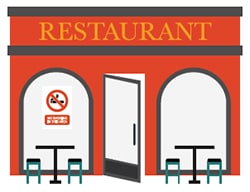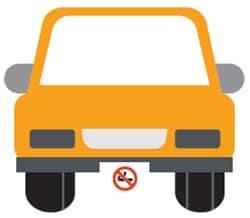Going Smokefree Matters: Bars and Restaurants
Bars and Restaurants
Every worker deserves to breathe smokefree air.

The Surgeon General concluded:
- There is no risk-free level of secondhand smoke1
- Separating smokers from nonsmokers, cleaning the air, and ventilating buildings cannot eliminate exposure of nonsmokers to secondhand smoke1
- Heating, air conditioning and ventilation systems alone cannot eliminate exposure to secondhand smoke1
- 100% smokefree workplace policies are the only effective way to eliminate secondhand smoke exposure in the workplace1
Did You Know?
Secondhand smoke has 7,000 chemicals, including 70 that cause cancer2
Since 1964, 2.5 million nonsmokers in the US died from problems caused by secondhand smoke exposure2
Secondhand smoke exposure in nonsmokers increases the risk of stroke 20% to 30%2
Secondhand Smoke Can Cause:
Heart disease
Lung Cancer
Respiratory disease
Adverse effects on the health of infants and children2
Exposure to secondhand smoke causes an estimated 41,000 deaths from lung cancer and heart disease among adults each year in the United States.3
Smokefree Policies:
- Improve Air Quality
- Improve Health
- Receive Public Support
- Reduce Secondhand Smoke Exposure
- Reduce Smoking
- Result in High Levels of Compliance
National Institute for Occupational Safety and Health (NIOSH)
NIOSH recommends establishing smokefree areas that protect from secondhand smoke and electronic cigarette emissions including:4

All indoor areas without exceptions

All areas immediately outside building entrances and air intakes

All work vehicles
States and Smokefree Indoor Air Laws

Twenty-four states do not yet have comprehensive smokefree indoor air laws covering all bars, restaurants and worksites.
For more information about state legislative coding, please visit CDC’s STATE System.
- U.S. Department of Health and Human Services. The Health Consequences of Involuntary Exposure to Tobacco Smoke: A Report of the Surgeon General—Executive Summary. U.S. Department of Health and Human Services, Centers for Disease Control and Prevention, Coordinating Center for Health Promotion, National Center for Chronic Disease Prevention and Health Promotion, Office on Smoking and Health, 2006.
- U.S. Department of Health and Human Services. The Health Consequences of Smoking—50 Years of Progress: A Report of the Surgeon General. Atlanta, GA: U.S. Department of Health and Human Services, Centers for Disease Control and Prevention, National Center for Chronic Disease Prevention and Health Promotion, Office on Smoking and Health, 2014.
- U.S. Department of Health and Human Services. A Report of the Surgeon General: Secondhand Smoke: What It Means to You. Atlanta: U.S. Department of Health and Human Services, Centers for Disease Control and Prevention, National Center for Chronic Disease Prevention and Health Promotion, Office on Smoking and Health, 2006.
- NIOSH [2015]. Current intelligence bulletin 67: promoting health and preventing disease and injury through workplace tobacco policies. By Castellan RM, Chosewood LC, Trout D, Wagner GR, Caruso CC, Mazurek J, McCrone SH, Weissman DN. Morgantown, WV: U.S. Department of Health and Human Services, Centers for Disease Control and Prevention, National Institute for Occupational Safety and Health, DHHS (NIOSH) Publication No. 2015-113.


